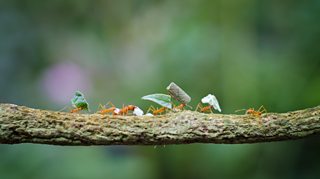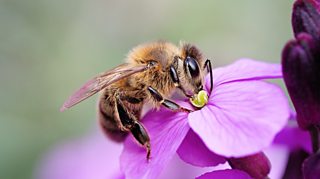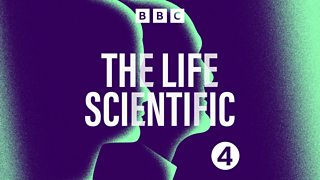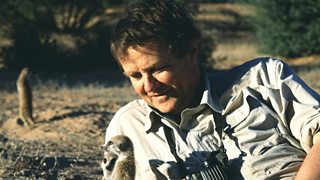Adam Hart: 10 things we learned about social insects
For The Life Scientific, biologist, entomologist and broadcaster Professor Adam Hart talks to Jim Al-Khalili at the Hay Festival. Adam, who once gave a non-stop 24-hour public lecture about social insects, looks back on some of his pioneering experiments with ants and bees, complete with a demonstration of the "hive mind" with both a waggle dance and a tremble dance!
Here are 10 things we learned.

1. Insects are the dominant species
There are an estimated 9 to 10 million species on earth. In the programme, Adam uses a 10kg bag of rice to demonstrate the dominance of insect species.

“There's about 50 grains of rice in a gram, which means that in this 10kg bag of rice there are about half a million grains of rice. If we get 20 of these sacks of rice, we can represent 10 million species on Earth. So, if you imagine you've got all of these sacks of rice lined up here on a stage – budget and logistics wouldn't allow us to get all of them – at least half, or possibly as many as 80%, would be insects.”
2. Leafcutter ants are doing it for the fungus
Adam’s first brush with ants was in the rainforest of Palenque in Mexico. By chance, he witnessed “great conveyor belts of leaves going through the forest, coming down from the trees.”
They were being carried by leafcutter ants. “The trail I saw was maybe… half a metre wide. You're talking tens of thousands of ants passing you every minute and monstrous amounts of leaves.”
The ants, the dominant herbivore of the forest, don’t feed on the leaves, they use them to feed a fungus that they farm.
“When you're actually there and you see it and you hear it, and you can see them skeletonising a tree back to its branches, you realise just how powerful a force they are.”
3. Insects can delegate
Among social insects, such as bees, wasps, ants and termites, "task allocation" and "task partitioning" are often observed. Task partitioning essentially means breaking a single job down into sub-tasks.
“So, a foraging, leaf-cutting ant is a good example,” says Adam. “They will cut the leaf in the tree, they'll carry it back to the nest and then they'll chew it up and stick it in their fungus garden. That's actually one job – foraging – but it involves about eight different ants in some cases.”
4. Ants can solve problems
The logistical skills of leafcutter ants extend to some classic problem-solving too. If, for example, they are faced with a flood blocking off their path, they will place their leaves in a pile for the next forager patrol to pick up and go back to cut more leaves in the meantime.
They don't get locked into roles necessarily. If something needs doing, they generally get it done.Adam Hart on leafcutter ants
“Whenever they come across these obstacles, which are too time-consuming at that point to fix, they will drop the leaf and go and do something more efficient,” explains Adam. “They don't get locked into roles necessarily. If something needs doing, they generally get it done.”
5. Honey bees are planners too!
Ants are not the only social insects to break down their foraging tasks.
Honey bees “need to get that nectar into those lovely little hexagonal wax cells that we're all so familiar with,” says Adam. “Mostly, they will go back to the entrance to the hive and then they will regurgitate the nectar into the mouth of another bee - a lovely process called trophallaxis - and those receivables, as they're called, will be the ones that go and store it.”
6. Bees do a waggle dance…
Demonstrating an incredible grasp of mathematics, honey bees can communicate distance and direction to tell each other where nectar is. The process is known as a ‘waggle dance’.
The dance movement takes place within two intersecting D shapes, and the middle part is the bee’s ‘waggle run’. The angle from which they depart the vertical run is the same angle of the food to the sun, “or more accurately,” says Adam, “where the sun would be if it dropped to the horizon.”
“So, if you imagine if the sun is straight in front of us, and the nectar is straight in front of us, they would dance vertically up.”
The bees need to know distance too. The rule is that the longer the dance lasts, the further away the nectar is. “It's about a second every hundred metres,” explains Adam, adding: “the stronger the nectar is, the more you do it.”

Bees dance to tell each other where food is
Adam Hart explains the 'waggle dance'.
7. …and also tremble dance.
Instead of transferring all of their nectar in one go, bees do three or four transfers. Adam set up a very intricate experiment to track and understand this behaviour. The result showed that the "tremble dance", where bees literally shake from side to side, was part of a supermarket-style checkout system in which bees deposit nectar and recruit others to pick it up, and so avoid overloading.

In 20 years’ time, we'll be quite used to buying insect protein-based foodAdam Hart
“There's a very small period of time during the year where they actually pile in most of the nectar that they need to get them over the winter,” says Adam, “so it's really crucial they get it right.”
8. Insects are not toasters!
It’s generally accepted that the hive mind is, as Adam says, “capable of doing some really quite challenging tasks.” Individual bee intelligence is harder to work out.
However, with their mathematical nous in relation to plotting distance and direction, it’s fair to say that bees are more than pollen-collecting drones and that “there's a lot going on inside a group of neurones, not much bigger than a pinhead.” That’s Adam’s take, and to underline it he quotes another a fellow scientist who, on another Radio 4 show, observed: “They don't have the rich, internal lives that we have, but they're not a toaster.”
9. We will be eating insects for tea
Insects are potentially revolutionary in offering a protein alternative to meat, although the notion of individual insect intelligence means that there’s an ethical factor in the mix.
A lot of the research into entomophagy, as eating insects is known, is actually focused on new animal feed – replacing fishmeal with black soldier flies, for example. However, Adam believes that insect foodstuffs for humans could become the norm.
“I don't think any of us right now are going to be wandering down to the supermarket to buy a box of crickets to fry up,” he says, “but, in 20 years’ time, we'll be quite used to buying insect protein-based food. It won't have legs pointing out of it and wings, it'll be processed in a way that's palatable.”
10. Bees are not always busy
When you see bees in the hive, doing waggle dances and tremble dances, or out foraging, you imagine that the saying "as busy as a bee" might apply most of the time. However, Adam notes that bees “do spend a lot of time resting”.
“It’s quite adaptive, really, because they're not wasting energy, but also, they're not running around getting in each other's way, which also means they're not spreading parasites and things.”
“There is a definite advantage in not doing anything if there's nothing to be done, and that's a nice lesson for us to learn from them.”
Listen to Adam Hart on ants, bees and insect burgers
More from �������� Radio 4
-
![]()
On the Menu
Adam Hart tracks the evolution of this most primordial of relationships between hunter and hunted.
-
![]()
The Life Scientific
Tim Clutton-Brock on meerkats, red deer and evolution.
-
![]()
The Life Scientific
Ben Garrod on conservation and extinction.





